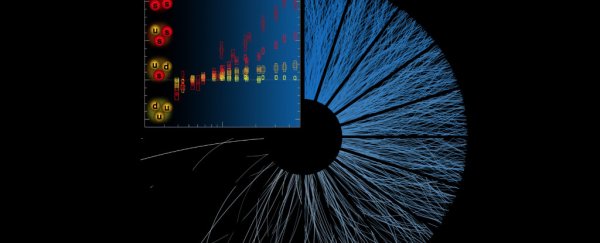Physicists at CERN have reported an unexplained phenomenon in their giant ion collider device - for the first time ever, particles called 'strange hadrons' have been observed in rare proton collisions.
These strange hadrons aren't new - we find them in quark-gluon plasma, which is the incredibly hot and dense state of matter thought to exist a few millionths of a second after the Big Bang. But finding them in proton-proton collisions is unheard-of, and if the result can be confirmed, it could have big consequences for particle physics.
"We are very excited about this discovery," says Federico Antinori, spokesperson of the ALICE collaboration at CERN.
"We are again learning a lot about this primordial state of matter. Being able to isolate the quark-gluon-plasma-like phenomena in a smaller and simpler system, such as the collision between two protons, opens up an entirely new dimension for the study of the properties of the fundamental state that our Universe emerged from."
Quark-gluon plasma is an exotic mixture of quarks, which are the smallest building blocks of matter that current physics models have confirmed. Quarks make up protons and neutrons, and are held together by a massless form of matter called gluons.
Because of how strong the force is between quarks and gluons, no one's ever witnessed a quark in isolation. What makes finding them so difficult is that quark-gluon plasma no longer exists naturally in the Universe - it's thought to have only formed at the birth of the Universe.
In order to study it, physicists have to recreate this exotic 'soup' by facilitating high-energy collisions between heavy ions of gold and lead inside CERN's Large Hadron Collider (LHC) experiment, and the New York-based Relativistic Heavy Ion Collider.
These experiments have successfully mimicked conditions that existed about 10-12 seconds after the Big Bang, by achieving temperatures of between 4 and 6 trillion degrees Celsius, or about 100,000 times hotter than the centre of the Sun.
It won't surprise you, then, to hear that this replica quark-gluon plasma is the hottest matter ever produced on Earth.
Because the ALICE collaboration is designed to interrogate the physics of strongly interacting matter at extreme energy densities - just like at the beginning of the Universe - researchers at CERN decided to investigate if it too had managed to create quark-gluon plasma.
After poring through data of various proton collisions carried out by the massive ion collider between 2009 and 2013, searching for a key signature of this primordial soup, they finally found one - strange hadrons.
As Avaneesh Pandey reports for the International Business Times, strange hadrons contain at least one 'strange quark' - one of the six known 'flavours' of quarks - which are produced in much greater numbers than non-strange ones in the presence of quark-gluon plasma.
"To their surprise, the researchers found that this 'enhanced strangeness production' was manifested even during proton collisions," says Pandey.
 As the number of particles produced in proton collisions (the blue lines) increase, the more strange hadrons are measured (range to red squares in the graph) Credit: ALICE/CERN)
As the number of particles produced in proton collisions (the blue lines) increase, the more strange hadrons are measured (range to red squares in the graph) Credit: ALICE/CERN)
If these strange hadrons really are an indication that quark-gluon plasma has been produced by the ALICE Collaboration, it's a big discovery - we've only ever seen quark-gluon plasma result from heavy ion collisions, and never proton collisions.
"[T]his is first time ever that such a phenomenon is unambiguously observed in the rare proton collisions in which many particles are created," a CERN press release reports.
"This result is likely to challenge existing theoretical models that do not predict an increase of strange particles in these events."
The researchers are careful to point out that production of quark-gluon plasma itself has not yet been confirmed - strange hadrons are just one signature of the exotic matter.
In order to confirm the discovery of quark-gluon plasma in proton collisions, a number of other signatures of quark-gluon plasma will need to be observed, such as jets of particles in the ALICE experiment being suppressed by the presence of this dense goo.
The team also points out that many new discoveries at CERN have later been discounted as errors in the data, so at this stage, they're reporting that only one signature of it has cropped up in their results.
But if the presence of quark-gluon plasma in the ALICE ion collider can be confirmed, it would mean scientists have a new, far easier, way to produce it.
"If you produce quark-gluon plasma in proton-proton collisions, you can think about shifting your attention there," ALICE researcher Livio Bianchi told Gizmodo. "Protons are much easier to treat [than heavy ions]."
The find will also help physicists understand the behaviour of matter at the smallest (quantum) scale - something that could finally help them formulate a unified theory of modern physics.
"Studying these processes more precisely will be key to better understanding the microscopic mechanisms of the quark-gluon plasma, and the collective behaviour of particles in small systems," CERN explains.
The research has been published in Nature Physics.
